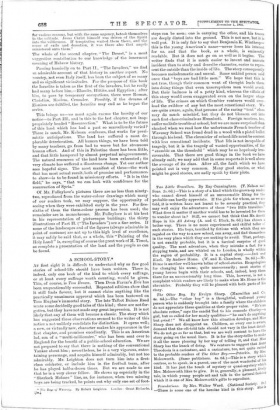GIFT-BOOKS.
THE HOLY LAND.*
WE have included this volume among " Gift-Books " for the very convincing reason that it would not be easy to find a better book to give away. But it must not be supposed that it is a book specially adapted for young readers. The pictures will, of course, appeal to all, but the description is one whieh older readers only will fully appreciate. It is curiously unlike what the average writer of travel in Palestine has to say. There is nothing of the guide-book about it; there are very. few experiences of travel in it, and these only illustrative of more important things ; we find no praise or blame of drago- man or Bedouin ; there is no controversy, acrimonious or other, about the Traditional Sites. What Mr. Kelman gives us is a very thoughtful, and even philosophical, account of the land and its people. Part L bears theY title of "The Land." Here Mr. Kelman is under obligations, which, indeed, a writer on the subject could hardly avoid, to Professor G. Adam. Smith, obligations which he amply acknowledges. But he has very successfully assimilated the matter which he uses. What he says about the relation between Palestine and the desert is an instance of his treatment. "Greece and Britain are not more truly children of the sea than is Syria the desert's child." "To the dwellers west of Jordan it was at once an enemy and an ancient home." The glowing descrip- tions of its beauty and fertility, its glorification as a land flowing with milk and honey, are the outcome of experiences of the desert. They seem exaggerations to the traveller, even with' allowance made for the deterioration of nearly two millenniums, but they were real enough and true enough to those who had struggled out of the land of death to life and safety. The meanest spring was a fountain to one who had narrowly escaped the fatal thirst of the interminable leagues of sand. Nor is the spiritual side of the matter less significant.' Here it is the home and not the enemy :— " When the Syrian retreats to the desert he seems rather to be going home than abroad. David and Elijah, Paul and Mohammed, • The Holy Land. Painted by John Pulleylove. Descr.bel by John Kelman, London: S. and C. Black. [21.1s. net. j for various reasons, but with the same urgency, betook themselves to the solitude. Jesus Christ himself was driven of the Spirit into the wilderness. If temptation waited them there, and the sense of exile and desertion, it was there also that angels ministered unto them."
The whole of the second chapter, "The Desert," is a most suggestive contribution to our knowledge of the innermost meaning of Hebrew history.
Passing hurriedly on to Part II., "The Invaders," we find an admirable account of that history in another aspect. No sountry, not even Italy itself, has been the subject of so many and so significant vicissitudes. For the purpose of this book the Israelite is taken as the first of the invaders, but he really bad many before him,—Elamite, Hittite, and Egyptian ; after him, to pass by temporary occupations, there were Roman, Christian, Moslem, Crusader. Possibly, if the dreams of Zionism are fulfilled, the Israelite may end as he began the series.
This brings us—we must again excuse the brevity of our notice—to Part III., and in this to the last chapter, not inap- propriately beaded "Resurrection." What is to be the future of this land which has had a past so marvellously varied ? There is much, Mr. Kelman confesses, that works for pessi- mistic anticipations. The land has suffered a most de- plorable deterioration. All human things, we have been told by many teachers, go from bad to worse but for strenuous human effort. And of this in Palestine there has been little, and that little hampered by almost perpetual misgovernment. The natural resources of the land have been exhausted ; its very climate has suffered a disastrous change. Yet our author sees hopeful signs. The most manifest of these—the work that has most actual result, both of promise and performance, to show—is to be found in missionary efforts. "It is in this field," be says, "that we can look with confidence for the resurrection of Syria."
Of Mr. Fulleylove's pictures there are no less than ninety- two, reproduced from the water-colour drawings which many of our readers took, we may suppose, the opportunity of seeing when they were exhibited early in the year. For five. sixths of them the three-colour process has been used ; the remainder are in monochrome. Mr. Fulleylove is at his best in his representation of picturesque buildings ; the thirty illustrations of Part IL (" The Invaders ") are a fine series. If some of the landscapes and of the figures (always admirable in point of costume) are not up to this high level of excellence, it may safely be said that, as a whole, this "Painting of the Holy Land" is, excepting of course the great work of M. Tissot, as complete a presentation of the land and the people as can be found.























































 Previous page
Previous page